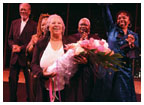
|
July 19, 2006: Notebook
Clinton challenges seniors to 'do it right'
New buildings, new gateways
Planning for the future
Designing a ‘world-class' chemistry building
Muldoon, arts center embark on ‘adventure'
Finding art in science Courtesy art of science competition
Five most popular certificates for the Class of 2006
Eight alumni elected as Princeton trustees
Study: Students harming selves
Former president Bill Clinton checks out his new class jacket as, from left, seniors Lauren Bush, Harrison Frist, and Shaun Callaghan and class president Chris Lloyd (at podium) look on. (Denise Applewhite/Office of Communications) |
Clinton challenges seniors to 'do it right'
As students from the Class of 2006 held digital cameras high to catch a glimpse of former president Bill Clinton entering Cannon Green to deliver the keynote address on Class Day June 5, a large cluster of class members began chanting "four more years." Lauren Bush '06, granddaughter of Clinton's presidential predecessor and onetime opponent, introduced the speaker as her "grandfather's favorite new traveling buddy." And from behind the podium, Clinton joked about Senate majority leader Bill Frist '74 "putting parenthood ahead of the public trust" by leaving the Capitol to see the graduation of his son, Harrison '06, a member of the committee that invited the Class Day speaker.
Clinton took a more serious tone as he asked the soon-to-be graduates to consider what impact they will have on the world. "You leave here with knowledge, a honed capacity for lifelong learning, and, frankly, your contacts with each other, which together give you an enormous amount of personal power in an interdependent world," he said. "How will you use it?"
Clinton urged the seniors to think about the 21st-century world, how they would like to change it, how to go about making those changes, and what roles they could take in effecting change. In outlining his own answers to those questions, Clinton spoke about global interdependence, not only in the world economy but in communications, culture, and a "shared vulnerability" to dangers such as terrorism, weapons of mass destruction, disease, and global warming. He also highlighted the world's inequalities in areas such as public health, and said that to correct these problems, people of the world need to form "integrated communities" in which values, responsibilities, and benefits are shared by all.
Clinton recounted his recent experiences with former president George H. W. Bush raising money for those affected by the December 2004 tsunami in Southeast Asia and the victims of Hurricane Katrina last year. In the former case, Clinton cited polls that showed how U.S. assistance helped raise America's standing among Muslims in Indonesia. Other opportunities exist, he said, thanks to the rise of nongovernmental organizations, the larger proportion of the world's citizens living in democracies, and the Internet, which provides an important new tool for free speech and fundraising.
"You live in a time which has given you unprecedented personal
power," Clinton said. "That means you've got a lot of responsibility.
It also means if you do it right, you'll live in the most exciting, interesting
time in all of human history. It's yours to make, and I hope you will."
![]()
By B.T.

(Denise Applewhite/Office of Communications) |
Milton Babbitt *92, Princeton professor of music, emeritus and a noted
composer and theorist, plays a jazzy ballad after the conclusion of
a concert May 21 at Taplin Auditorium to celebrate his 90th birthday.
Behind him are, from left, violinist Curtis Macomber, soprano Judith
Bettina, and pianist Robert Taub '77. The three performed a number of
pieces by Babbitt, ranging from three theatrical songs composed in 1946
to a piece that premiered 60 years later. About 150 people attended
the tribute to Babbitt, described by music department chairman Scott
Burnham as "our
friendly legend and legendary friend." [See
A Moment With Milton Babbitt, click here.] ![]()

New
buildings, new gateways
Planning for the future
As the student body expands, Princeton's campus will continue to grow, but much of the construction in the next two decades will be spurred by research, not undergraduate life, according to University architect Jon Hlafter '61 *63. New buildings for chemistry, neuroscience, and operations research and financial engineering are among the University's most immediate plans. "Research universities grow," Hlafter said, "because fields of knowledge grow."
Hlafter shared updates from the University's latest planning effort with the Council of the Princeton University Community in May. The two-year project began last October when the University hired the planning and architecture firm of Beyer Blinder Belle to help create a long-term plan that would balance the guiding principles described by President Tilghman last year. Those principles include preserving Princeton's parklike qualities and building with pedestrians in mind so that all academic buildings and undergraduate dormitories are located within a 10-minute walk of the Frist Campus Center.
When the planning effort was announced, executive vice president Mark Burstein said that the University hoped to address issues that are broader than individual construction projects, such as parking, traffic (for both pedestrians and automobiles), landscaping, and lighting. According to Hlafter, rethinking the campus's gateways is also high on the list. FitzRandolph Gate may be Princeton's symbolic front door, but more visitors approach the campus from Washington Road or Alexander Street. A proposed pedestrian bridge on Washington Road and a new neighborhood for the arts near McCarter Theatre could redefine the sights people see as they arrive at Princeton, Hlafter said.
Princeton's last campus plan, completed in 1996, envisioned a group
of buildings along the ellipse above Poe and Pardee fields, an idea that
was realized with the construction of the Carl Icahn Laboratory, Scully
Hall, and Bloomberg Hall. This time, the focus is on the E-Quad and its
surrounding area; the natural sciences neighborhood, which stretches from
Guyot Hall to the Armory site, where the new chemistry building will stand;
and the area near the intersection of Alexander Street and University
Place, targeted to become a hub for the performing arts. ![]()
By B.T.

An architect's rendering of the new chemistry building, which will be located on the site of the Armory next to Princeton Stadium. (Office of Communications) |
Designing a ‘world-class' chemistry building
Princeton's new chemistry building will be highlighted by a four-story, atrium-like "street" that runs through its center. Offices will be on one side, and 60-foot-wide laboratories will be on the other.
"This will be a world-class chemistry building, with all the best technological systems we can afford and the most pleasant working spaces," said Robert Cava, chairman of the chemistry department. The building was designed by Hopkins Architects of London.
The 248,000-square-foot building, scaled back about 20 percent from its original design, is to be located on the site of the Armory adjacent to Jadwin Hall and Princeton Stadium. Construction is expected to last from fall 2007 to spring 2010.
The new building has a "very green" design to maximize its energy efficiency, Cava said. He estimated that chemistry's current home, the 77-year-old Frick Laboratory, consumes 8 percent of the University's energy to meet ventilation requirements.
The University previously has said that royalties from the patent for
Alimta, a cancer-fighting drug developed in part by professor emeritus
Edward C. Taylor, will support the cost of constructing the chemistry
building. ![]()
By W.R.O.

(Architecture Research Office) |
Work has begun on a new, glass-enclosed
addition to the School of Architecture building that will link the office/library
and classroom/studio wings. The addition, which faces 1879 and Marx halls,
will include a two-story lobby, an elevator, stairs, and a student lounge
on the top level. Interior renovations include moving the computer lab
and the shop and laser cutters to the ground floor of the building, which
was completed in 1963. The project was designed by Adam Yarinsky *87 and
Stephen Cassell '86 of Architecture Research Office, a New York firm,
and should be completed by December. ![]()

Alan Chimacoff |
Campus
perspective
‘Quintessentially
Princeton'
By Alan Chimacoff
As the University embarks on a new round of campus planning, PAW asked former architecture professor Alan Chimacoff, a partner in the firm of ikon.5, to select three to five locations on campus that are "quintessentially Princeton." Chimacoff, who teaches a freshman seminar called "Eye of the Tiger: Reading Buildings," has specialized in college architecture; his work at Princeton includes Bowen Hall and the 1993 expansion of the E-Quad. Following are his selections, with digital renderings by Ricardo Barros.
The request from PAW came as a surprise, since I have neither credential nor birthright to be considered the arbiter of what is quintessentially Princeton (QP) — just an abiding interest in the Princeton campus and its architecture over the more than 30 years since I came to teach in the School of Architecture. During my time on the Princeton faculty, between 1973 and 1986, I served on the President's Advisory Committee on Architecture, no doubt a factor contributing to my deep interest.
In making selections for the QP pantheon — three to five locations, a daunting task — I adopted a broader (and more fallible) view of the architecture that is "quintessentially Princeton." There is as much "spatial" in these selections — on what lies between the buildings — as there is a focus on individual buildings. That is significantly what a campus and a university are about: not so much the objects as the spaces in between.
In the process, I consulted via e-mail all the students in my "Eye of the Tiger" classes over the last four years. Twenty of the 50-plus students responded to my request for comment and criticism, and their bold and astute answers adjusted my thought processes and selections (inevitably, teachers learn from their students).
What's not included? Since every selection is by nature exclusionary, there are buildings and spaces not on the final list that easily could be considered quintessential. It was painful not to include Alexander Hall and the brilliant collegiate gothic residence halls, Holder and Hamilton courts, and the amazing dining and social halls of Mathey and Rockefeller colleges. Had the imposed limit of three to five locations been 10, they surely would have made my list.
What's the "Q?" I have adopted a broader-than-expected definition of "quintessentially" to include institutional, intellectual, and social values, since these forces influence powerfully the shape of architecture and the development of campuses. There is no question that Princeton's historic architecture is quintessential to this place; however, to be a modern institution at the forefront of all intellectual pursuits, a great university needs to set its architectural sights beyond the next horizon.
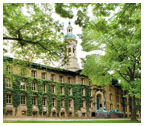

Nassau Hall
The place of origin of the University when it moved to Princeton as the
College of New Jersey. It bears a simple, strong, iconic image —
almost a logo of the University — and, early on, influenced a number
of other institutions in the creation of their initial building, including
Princeton Seminary and Brown University.


Whig and Clio Halls, Cannon Green and
Nassau Hall
This is the first "set piece" of the University as a campus
— the footprint of its origin — along with West College and
East Pyne, as an ensemble; after the front lawn it is the defining place
of the University.

Frist Campus Center
Bringing old and new together at the geographic center of the campus (and
again, regardless of whether one likes it or not architecturally), this
place has become, socially and in the day-to-day life of the University,
quintessentially part of the substance of life. Today's undergraduates
cannot imagine Princeton without Frist, one of Robert Venturi '47 *50's
noteworthy accomplishments on campus.
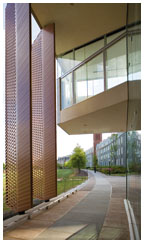

Carl Icahn Genomics Laboratory (also
at right)
A dramatic example, by Rafael Viñoly, of Princeton's current practice
of enlisting today's most prominent architects. The "Q" here
is that, consistent with the University's position at the forefront of
intellectual progress in all that it pursues academically, it should pursue
architecture at the intellectual forefront of its own discipline in the
continuing development of the campus. Other examples under way or soon
to be: the Lewis science library by Frank Gehry, the chemistry building
by Hopkins Architects, the Washington Road pedestrian bridge by Christian
Menn, and the ORFE building by Frederick Fisher.


McCosh/Dickinson Court
The three-sided courtyard formed by McCosh Hall, Dickinson Hall, and the
Chapel is the prime example of the spatial and organizational "Q"
of the campus — the long vista into an open-ended courtyard, with
an identifying marker, here the Mather Sundial. Similar examples (not
illustrated) are looking west to the Campbell, Joline, Blair court, with
Blair Arch as the marker; and the remarkable view northward encompassing
Henry, Foulke, and Lockhart, again with Blair Arch as the marking terminus.


McCosh Walk/Robertson Hall
McCosh Walk, a principal cross-campus walkway, has one of the highest
"Q" quotients of the campus. Pairing it with Robertson Hall,
its eastern terminus, is purposely controversial. Robertson is a building
that many consider beautiful, bright, lively, and graceful, while others
(myself included) consider it a misinformed appropriation of themes and
elements of classical architecture. Why is it an example of QP? Broadening
the definition of "quintessential," it stands for the fallibility
of an institution: Even great institutions, led by great minds, make questionable
judgments, especially about architecture. Incorporating Robertson in these
selections is a continuing caution. ![]()
Add your views: Which locations on campus would you select as quintessentially Princeton? Write to PAW or e-mail paw@princeton.edu. Responses will be posted online.

NASA's sweeping vision for human space exploration, which includes a return to the moon by 2020 followed by missions to Mars, presents a range of technical challenges to the next generation of aerospace engineers. But according to Harrison Schmitt, an Apollo astronaut who heads the NASA Advisory Council, building momentum and widespread support before the next presidential administration takes office could prove to be just as important for the future of the project. "We've got to do everything we say we're going to do, do it extremely well, and at an increasingly lower cost," Schmitt told a Princeton audience at a May 10 panel discussion, "in order to survive that part of the space initiative."
Schmitt, the last man to walk on the moon, headlined the Princeton Astrobiology Club's Human Spaceflight Forum, which also included astronaut Jim Wetherbee, a veteran of six Space Shuttle missions; Kennedy Space Center deputy director Bill Parsons; professors Jeremy Kasdin '85 (mechanical and aerospace engineering) and Tullis Onstott *81 (geosciences), who are both involved in NASA-sponsored projects; and George Whitesides '96, director of the National Space Society.
Much of the group's discussion focused on what future NASA missions and future astronauts will look like. As NASA draws nearer to a Mars mission, Schmitt and Wetherbee said, combining human skills and robotics will be critical, and the next generation of astronauts will need to sustain strong operational and decision-making skills over long periods of time. In six missions combined, Wetherbee spent more than 66 days in space; just getting to Mars could take nine months or longer.
The panelists also explored ways to build public support for space exploration.
Whitesides, an advocate of both governmental and commercial space travel,
suggested that NASA begin selecting astronauts for its future lunar missions
to put a human face on the program and generate excitement. But Onstott,
whose research includes an astrobiology project to search for life beneath
the surface of Mars, said the recent experience of the Mars Rovers showed
that "exciting science that ordinary people can appreciate"
can capture the public's imagination. ![]()
By B.T.

Muldoon, arts center embark on ‘adventure'
This summer, the University's new Center for the Creative and Performing Arts and its inaugural director, Paul Muldoon, will gather ideas for a new arts neighborhood south of McCarter Theatre, bolster funding and infrastructure for existing arts programs, and hire an associate director responsible for day-to-day oversight. The steps mark the beginning of one of the broadest expansions of the arts in Princeton history, and Muldoon said the center is approaching the process with a "spirit of adventure."
The arts initiative, made possible by a $101 million gift from Peter B. Lewis '55, has a long-term outlook that does not include major curricular changes in the coming academic year, according to Muldoon. But the University has announced one notable contributor to the changes on the horizon: Renzo Piano Building Workshop, the firm responsible for the recent renovations to the Morgan Library and Museum in New York, will design the arts neighborhood, to be constructed near the intersection of University Place and Alexander Street.
Plans for growth in the arts have been received positively on campus, but there was some negative feedback when the University announced its intention to add performing and visual arts spaces and local retail stores to the area west of the Dinky station. A front-page Daily Princetonian headline declared, "New arts complex may force Wawa departure." Muldoon said he can understand the resistance to change — and the comfort of a 3 a.m. snack — but he hopes that students will see the larger picture.
"Art is about change — it's all about change — and
it's about reimagining oneself," Muldoon said. "The great Irish
poet W.B. Yeats writes, ‘Myself I must remake.' And the University
has a wonderful opportunity here to remake its own view of itself."
![]()
By B.T.

Finding art in science Courtesy art of science competition
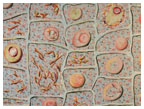

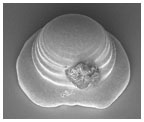
Images Courtesy Art of Science Competition
Jennifer Rea '06, a history of science major, won first place in the
University's second Art of Science competition for her work, left, "Mitosis,"
which superimposes images of mitosis and cell division on a floral fabric.
Second place went to Melissa Green, a graduate student in the Department
of Mechanical and Aerospace Engineering, for "Isolated Hairpin"
(top right), a computer simulation of turbulent air flow. Qiangfei Xia,
an electrical engineering graduate student, won third prize for "Easter
bonnet," the result of a microscopic piece of metal melted by a laser
pulse on a silicon chip. A gallery of works is on display in the Friend
Center. It can also be viewed online at www.princeton.edu/artofscience/gallery2006.
![]()

Eight alumni elected as Princeton trustees
Eight alumni have been named to the University's Board of Trustees. They are:
Shelby Davis '58 of Tuxedo Park, N.Y., founder of Davis Selected Advisers, a mutual fund management company. He established the Davis United World College Scholars Program at Princeton and four other institutions.
Carl Ferenbach III '64, managing director of Berkshire Partners, a private equity investment firm in Boston.
Charles Gibson '65 of New York, recently named anchor of ABC's World News Tonight.
Ellen Harvey '76 of Bryn Mawr, Pa., senior vice president at Mercantile Bankshares Corp. in Baltimore.
Robert Murley '72 of Lake Forest, Ill., vice chairman of Credit Suisse First Boston in Chicago. Murley, who served as a charter trustee from 1995 to 2005, is one of three co-chairs of the fundraising campaign being planned at Princeton.
John O'Brien '65, president of the Milton Hershey School in Hershey, Pa.
Mark Siegler '63, the Lindy Bergman Distinguished Service Professor of Medicine and Surgery and founding director of the MacLean Center for Clinical Medical Ethics at the University of Chicago.
Brady Walkinshaw '06 of Nooksack Valley, Wash., who co-chaired the Student Volunteers Council and was a member of the Pace Center oversight board.
Murley was elected to a 10-year term as a charter trustee; the others
will serve four-year terms. The board has 40 members. ![]()

Illustration by Steven Veach
In addition to their bachelor's degrees, members of the Class of 2006 received 801 "certificates of proficiency" at Commencement (certificates are akin to academic minors, and each student can pursue up to four). In May, the faculty approved new certificates in urban studies and quantitative and computational biology, increasing the number of programs to 35 in the coming year, according to the registrar's office.
Senior mechanical and aerospace engineering major Allison Squires earned
certificates in robotics, engineering physics, and Chinese language and
culture. For an MAE concentrator, picking up the robotics certificate
was a relatively simple, she said, but the Chinese certificate required
careful scheduling and a few semesters of taking five or six courses.
"Although it involved some extra work, I would have taken most of
the classes anyway," said Squires, who will pursue a doctorate in
applied optics and nanotechnology at Boston University in the fall. ![]()
Five most popular certificates for the Class of 2006
| Certificate Finance Woodrow Wilson School Engineering and Management Systems Spanish Language and Culture Applications of Computing Source: Office of the Registrar |
Students 156 86 49 44 30 |
By B.T.

(Steven Veach) |
Easier said
Having an easily pronounced company name or a pronounceable ticker symbol
(BAT instead of LHT, for instance) can have a positive influence on a
stock's performance immediately following its initial public offering,
according to research from the Princeton psychology department published
by the Proceedings of the National Academy of Sciences. The research by
Ph.D. student Adam Alter and assistant professor Daniel Oppenheimer was
based on the idea that people respond to information that is easily processed.
While the benefits of a pronounceable name waned over time, they were
remarkable in the short term: In the opening day of trading, a $1,000
investment in the 10 most fluently named stocks outperformed the same
investment in the 10 least fluently named stocks by $112. (The study used
NYSE and AMEX data.) Economists have tried to explain short-term stock
price fluctuations with complex models, the authors say, but "sometimes
a surprisingly simple theory is a successful predictor of human behavior."
Sound science
Engineers — and drivers with sunroofs — have known for decades
that air passing over an open void tends to produce a flapping noise.
But reliably combating the sound created by the oscillating air remains
a mystery. In January, assistant professor of mechanical and aerospace
engineering Clarence Rowley '95 published research that demonstrated a
new system to minimize the noise by "fighting sound with sound,"
according to a University release. The research, funded by the U.S. Air
Force Office of Scientific Research, could lead to jet engines that produce
less noise and stealth aircraft that could fly quietly with their weapons
bays open. In computer simulations and wind tunnel experiments, Rowley
and colleagues from the Illinois Institute of Technology and Caltech used
a model that resembled a car with an open sunroof. Focusing on the layer
of air just above the roof, they monitored the sound of the air flow with
a microphone in the back of the open cavity and, depending on the noise,
sent a corresponding sound from a speaker at the front of the cavity.
The result was to redirect the air and create a smooth, quiet flow across
the open space.
![]()

Study: Students harming selves
One in six students on the Princeton and Cornell campuses have intentionally cut, burned, or injured themselves in other ways, according to a new study published in the June issue of Pediatrics.
The study is consistent with national trends, researchers said.
"Self-injurious behavior may be a serious problem for certain college students who are experiencing psychological distress," said Dr. Daniel Silverman, Princeton's chief medical officer and one of three researchers who conducted the survey of more than 3,000 students that formed the basis of the study.
Silverman urged faculty, coaches, administrators, parents, and friends to ask students "struggling with severe stress whether they are relying upon self-injury as a way of trying to reduce tension or to cope with painful feelings."
Janis Whitlock, director of the Cornell Program on Self-Injurious Behaviors and lead author of the study, said self-mutilation is one of several disorders that have "increased significantly" in the past five years.
The study found that those who injure themselves are slightly more likely
to be female and are more likely to report eating disorders and suicidal
tendencies. ![]()

In June, University trustees added $24.8 million to Princeton's $1 billion operating budget in 2006–07 by changing the endowment spending policy. The University follows a formula that aims to keep annual endowment spending between 4 and 5 percent of the endowment's market value, and after three consecutive years of strong returns, the endowment's value had outpaced the formula's disbursements. More than $9 million of the new allotment will fund energy costs and reserves, construction, and renovations; $6.2 million will support an expansion of the development office. Funds also will be used for new research, recruitment and retention of faculty, upgrades in information technology on campus, and library acquisitions. In 2004–05, investment income financed 36.1 percent of the University budget, according to the treasurer's office.
The GRADUATE SCHOOL expects to enroll more women in the sciences and engineering, underrepresented minority students, and international students in the 2006–07 academic year, according to a report by Dean William Russel. Of the 577 students who have accepted offers for the incoming class, 86 are women in the sciences and engineering (up from 66 last year); 40 are from underrepresented minority groups (up from 34 last year); and 226 are international students (up from 196 last year). Applications from international students rose by about 10 percent for the second consecutive year but remain well below the peak level of more than 4,500 applications received in 2002–03. Overall, applications to the graduate school rose by 6 percent.
Among the new faces on campus in the fall will be some well-known scholars and political figures. MUHAMMAD ZAMAN, a scholar of contemporary Muslim studies who has taught at Brown since 1997, has been appointed the first Robert H. Niehaus '77 Professor of Near Eastern Studies and Religion. The position sparked some controversy in the spring of 2005 when it was reported that Columbia University Arab studies professor Rashid Khalidi was a candidate, drawing objections from some students and alumni concerned by Khalidi's public statements. JOSCHKA FISCHER, a militant left-wing activist in the 1970s who later became the German foreign minister, joins the Woodrow Wilson School for a one-year term as lecturer. Fischer and Professor Wolfgang F. Danspeckgruber will lead a fall graduate seminar, "International Crisis Diplomacy: Theories, Challenges, and Chances." Other faculty appointments include DAVID MACMILLAN, an authority in synthetic organic chemistry from Caltech, as the A. Barton Hepburn Professor of Organic Chemistry.
A gift from the FISHER FAMILY of San Francisco will pay for one of the new dorms of Whitman College, scheduled to open in the fall of 2007. The 50-student dorm will be called Fisher Hall. Making the gift were Doris and Donald Fisher, founders of Gap Inc.; Elizabeth and Robert Fisher '76, the current Gap chairman; William Fisher '79, managing partner of Manzanita Capital; and John Fisher '83, president of Pisces Inc. The Fisher family also provided funds for the home of the economics department (also called Fisher Hall), and is funding three classrooms to be located in Whitman College's Hargadon Hall.
The finance committee of the Board of Trustees voted June 5 to prevent
future investment in companies that directly or indirectly conduct operations
in the Darfur region of Sudan and support acts of genocide.
Prince-ton currently has no direct holdings in companies operating in
Sudan, according to Christopher McCrudden, vice president for finance
and treasurer. Five companies in which the University may have indirect
exposure through commingled accounts like hedge funds or mutual funds
"are being evaluated to determine the effect of their presence in
Darfur," McCrudden said. ![]()

(David Savatteri) |
Celebrating Toni Morrison
Princeton professor emeritus Toni Morrison is joined by actor Morgan Freeman, who praised her "grace and honesty and imagination and wisdom," and members of the vocal group Sweet Honey in the Rock at the end of an evening of performances and tributes to Morrison May 26. Among those appearing at the gala event, held at the Time Warner Center in New York City, were former president Bill Clinton, dancer Bill T. Jones, actress Phylicia Rashad, NPR radio host Tavis Smiley, and President Tilghman. The University announced that professor Cornel West *80 will inaugurate an annual lecture series this fall in honor of Morrison, a Nobel laureate and a Princeton humanities professor for 17 years.

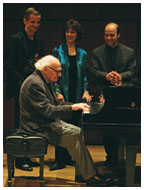

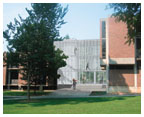

 Bright-eyed
and certified
Bright-eyed
and certified

